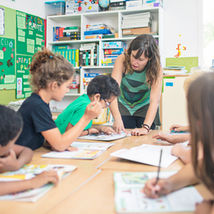How to Deal With Bullying in Schools
Updated: Aug 9

(Blog reposted from https://praxisexam.org/teacher-certification/bullying-guide-for-teachers/ with permission)
Bullying is a form of intentional harassment and antagonistic behavior perpetrated by one student against another. It can take many forms, from verbal insults to deliberate exclusion to physical violence. According to federal statistics, around one in five students between the ages of 12 and 18 experience bullying at school. It can have a profoundly negative effect on students' psychological well-being.
Fortunately, there are many ways that teachers can take action to help reduce instances of bullying and to help students form healthier, more positive relationships with one another. Getting educated about the impacts and causes of bullying, providing support to students, and teaching respectful conflict-resolution strategies can all be helpful.
Anti-Bullying Professional Development and Education
To address the issue of bullying in schools, a number of organizations have set up anti-bullying initiatives. One of the best ways that teachers can prepare themselves to deal with bullying in schools is to engage in various forms of anti-bullying professional development. Teachers have a responsibility to educate themselves about how bullying happens, what the warning signs are, which students are most likely to be at risk, and how best to resolve conflicts between students before bullying occurs. Reading up on bullying and attending relevant workshops are critical steps in the right direction.
Anti-Bullying Resources
There are many anti-bullying resources available for educators that can help shed light on how bullying happens and how it can be stopped. Individual schools and school districts may have their own resources, but federal organizations also have a wide range of research and initiatives. Resources can include websites, studies, books, films, testimonies from people who have experienced bullying, and more. Some options include:
Stop Bullying, a website created by the United States government that aims to prevent bullying in all educational settings
The Committee for Children goes into detail about what bullying is and how it can be prevented
STOMPOut Bullying explores the relationship between bullying and systemic discrimination while also giving actionable tools for teachers
Many of these resources discuss how teachers can work with students on both sides of a bullying relationship to dismantle patterns of aggression. For instance, it is often unhelpful to refer to a student as a bully, as though being a bully is a fixed trait. Instead, try referring to bullying as a behavior that can be changed.
Attend Workshops and Seminars Related to Bullying
It is one thing for teachers to read up on bullying in their own time, but it is also often helpful for teachers to attend workshops and seminars that address bullying and seek to change the prevailing narrative around it. These workshops provide valuable information and allow teachers to speak to each other about their own experiences. This discussion can help teachers share solutions that have worked for them and troubleshoot each other's classroom situations. Some workshops might also have roleplaying exercises and other tools to help teachers understand the reality of bullying and how they can teach students to manage it. If possible, teachers might want to look into options for hosting seminars at their own school so that all teachers in a given institution can be on the same page about how to manage bullying and how to create consistency in students' interactions with adults at school.
Promoting a Culture of Anti-Bullying
One of the most powerful tools that a teacher has for combatting bullying is the culture of a classroom or school. Teachers and administrators can work together to create an environment with a zero-tolerance policy for bullying among students. There are many different ways to create such a culture, and its creation will take time. It can be created within an individual classroom and an entire school. Teachers may need to take slightly different approaches depending on the age of their students and the specific classroom atmosphere. For example, a class of younger students that have not yet had any serious issues with bullying may respond more quickly and effectively to an anti-bullying environment than an older class where aggressive relationships between some students have already been established. That said, anti-bullying techniques can make a meaningful difference for all classrooms.
Teaching Anti-Bullying
Check out our curriculum that includes several anti-bullying lessons: www.cybercivics.com
One approach that teachers can take to prevent bullying is incorporating anti-bullying lessons into the classroom. It is possible to have just a few stand-alone anti-bullying lessons that can be highly effective. Teachers can also build anti-bullying micro-lessons into the curriculum to reinforce important ideas further. The important thing is to make anti-bullying part of the daily routine and curriculum so that students feel confident in their role in the classroom space.
Another way to teach anti-bullying is to host class-wide discussions. Have students speak about their own thoughts and experiences with bullying (though students should not feel pressured to speak or disclose personal information) so that everyone can understand each other's perspectives. It may be helpful to have students collectively come up with a set of guidelines for respectful behavior toward others. Write those guidelines down so that they can be seen by all and ideally kept in the classroom in the future. This can help give students a sense of agency in the discussion and can help them hold themselves and each other accountable to a mutual agreement.
Adopting an Anti-Bullying Initiative
Teachers can and should speak to their school's administration about setting up a school-wide anti-bullying initiative. Students of all ages can experience bullying, and an individual classroom's culture does not necessarily extend to other students in the school. Creating or adopting a campaign that allows all students to participate can create a stronger anti-bullying culture and can help students who are being bullied feel that they are able to speak up. Several anti-bullying and anti-discrimination campaigns already exist, some of which might be a good fit for an individual school's culture and goals. The Anti-Defamation League has a campaign called No Place for Hate, while The Trevor Project provides resources for LGBTQ youth facing bullying. Some other initiatives, like Delete Cyberbullying, focus primarily on bullying in the digital sphere, which can also impact many students. Schools can join an existing campaign or create a new one that meets their own students' needs.
Interacting with Students and Other Faculty
For teachers to truly make a difference in their student's lives when it comes to bullying, they will need to consider their own interactions with teachers, other faculty, and staff. Creating an anti-bullying culture means fostering a culture of respect for everyone. Teachers should always lead by example, going out of their way to be kind and understanding to others so that students have an opportunity to model their behavior on their teachers. When teachers see any bullying taking place, they must make it clear to students that such behavior is never acceptable. Consistency in a teacher's approach to bullying can make a difference over time as students learn that bullying will not be tolerated and that teachers are unwilling to turn a blind eye.
Although any student can experience bullying, certain risk factors make it more likely that students will be bullied in schools. Students who are members of a racial or ethnic minority, students whose first language is not English, LGBTQ students, and students with disabilities may all be more likely to be targets of bullying and discrimination. Students who are members of minority religions and students from low-income backgrounds may be similarly at risk. When speaking with students, teachers should make sure to create a welcoming and inclusive environment to reduce the risk of students facing discrimination while at school. Seeing teachers treat all students with respect can help students better understand their own biases.
Handling Specific Instances of Bullying
While professional development and classroom culture are essential and effective tools in combatting bullying, teachers are still likely to face situations where some students bully others. Understanding how to approach these situations and how to defuse aggressive relationships is challenging, but specific strategies can work. While there is no surefire way of preventing bullying from occurring, teachers who are patient and able to provide students with a consistent and practical approach to bullying are likely to see positive impacts from their actions among their students as time goes on. The following tips for intervening in bullying situations are not a one-size-fits-all approach. Teachers need to know their students and have a sense of the classroom and school cultures that have contributed to a particular interaction. They will also need to consider any forms of systemic discrimination present and reflect on those factors.

Intervening in Instances of Bullying
Intervening effectively when instances of bullying occur requires careful consideration of the situation. Teachers who witness bullying between students should immediately stop the interaction and speak to the students involved. If possible, the conversation should take place in a private environment. Teachers should hear both sides of the situation but should be prepared to explain to students that aggression and bullying are unacceptable at their school. Because of the challenging dynamic between students in a bullying relationship, teachers may want to speak to each student individually to understand the context of the interaction properly. Students engaging in bullying must understand that their actions are unacceptable, but they should also be met with compassion and respect from teachers. A safe classroom environment means safety for all, particularly as students engaging in bullying may be experiencing challenges of their own.
Collaborating with Faculty and Staff
Bullying is a complex issue, and it is not something that teachers need to handle alone. Educators should be familiar with their school's anti-bullying policy to know when and how to escalate a particular situation if needed. Whenever possible, faculty members, administrators, and staff members in a school should all be on the same page about addressing bullying. This consistency gives students a sense of stability and means they know what to expect when experiencing, reporting, or being disciplined for bullying. In particular, teachers should liaise consistently with guidance counselors and other support staff who may be interacting directly with students during challenging situations. When discussing bullying instances with other adults in a school environment, teachers should try to be as accurate and compassionate as possible. They should include relevant information without infringing on students' privacy or personal boundaries.
Talking to Individual Students About Bullying
If a student reports bullying to a teacher, the teacher should never ignore the report and should speak to the students involved. In severe cases, it may be necessary to go directly to an administrator or guidance counselor to get the necessary support for students. This is particularly important when physical violence or property destruction is involved in bullying. Racism, homophobia, and other discrimination may also require a guidance counselor or other assistance. Teachers must always be prepared to help students access proper mental health support if they make any references to self-harm, suicidal ideation, or other serious mental health symptoms.
Sometimes, complex bullying situations can even leave teachers unsure which students are doing the bullying. Speaking to students individually and together can help gain clarity. It is also worth keeping in mind that an argument between students is not the same as bullying; bullying is a pattern of aggressive behavior, not a single disagreement. Teachers should always prioritize open and honest communication and must make it clear to students that the main priority is students' safety in the educational environment. Bullying is a form of behavior that threatens that safety and makes education more difficult for all involved. Whenever possible, teachers should try to understand the underlying reasons for bullying.
Communicating with Parents About Bullying
It is sometimes necessary for teachers to communicate with parents about bullying taking place in the classroom. Engaging in this form of communication can be a delicate process that teachers should consider with great care. If a student is being bullied or is bullying another student and teachers feel that the parents need to be aware of the situation, it is generally best to start by consulting a supervisor or administrator to determine the best course of action. The school may have a specific policy for dealing with communication between teachers and parents. When talking to parents, teachers should always try to be clear and use polite but unambiguous language. Avoid blaming or making excuses, but stick to the facts instead. Parents are likely to be concerned about their child's experiences or actions and may have their own ways of approaching support or discipline. Teachers should know what they hope to communicate to parents and why. Knowing what to say can help give the conversation clarity and purpose and can help avoid misunderstandings.

Tips on Becoming a Teacher Who Promotes Anti-Bullying
All teachers will likely have to deal with a bullying relationship at some point in their careers. Prospective teachers can get a head start on handling instances of bullying by focusing on anti-bullying strategies during teacher education and training. By putting anti-bullying strategies and initiatives at the forefront of one's teacher education, it is possible to enter the field as an anti-bullying-focused educator who has the power to make a meaningful difference in students' lives. Becoming a teacher who promotes anti-bullying in the classroom can involve focusing on teacher exams and certification that give educators the tools they need to reduce instances of bullying. Some schools also have a stronger focus on anti-bullying than others; these schools may be a good starting point for teachers interested in helping students manage their experiences with bullying in a productive way.
Praxis Exams and Other Standardized Tests
The Praxis exam is one of several tests that teachers can (and sometimes must) take to become formally certified. Some states require the Praxis exam for those who are going to teach in public schools, while for other states, Praxis is optional, and other standardized tests are required. Prospective teachers studying for their exams should think of Praxis and other tests not simply as a step in the teacher training process, but rather an opportunity to thoroughly engage with pedagogical theory. Many exams test teachers on their ability to manage student conflicts, which can include bullying. It may be helpful to focus on the anti-bullying aspects of these tests to learn the best strategies for keeping students safe. The Praxis tests, like the Praxis Core test and Praxis II, should ideally prepare teachers for their future careers, which means preparing them for anything that might come up in the classroom.
Gaining Certification
Teachers who work in public schools across the United States need to be certified or licensed before they can teach. The certification and licensure process is different from one state to another, but the typical process is as follows:
Prospective teachers must obtain an undergraduate degree, usually in education
Educators must receive passing grades on one or more standardized exams that test their teaching abilities and pedagogical understanding
Teachers must work as student teachers in a real classroom environment to gain experience and work with established instructors
Teachers need to apply for certification or licensure once they have all of their credentials in place
The above steps apply broadly to public school teachers across the country, but not necessarily to private school teachers, who do not always need to be licensed. At every step in the teacher training process, teachers can and should ask mentors and professors questions about bullying and how to prevent it. The teacher training process is designed to prepare teachers for the highly dynamic environment of a classroom, and learning those skills requires time and practice. Teachers should aim to practice their anti-bullying skills as often as possible while preparing for certification.

Finding a Job in an Anti-Bullying School
For teachers who are serious about preventing bullying, finding a job at an anti-bullying school can be an excellent first step. Many schools already have robust anti-bullying policies in place that can help teachers create a positive environment for students. When looking for a teaching position, teachers might want to look for schools that are already affiliated with existing anti-bullying campaigns like No Place for Hate. Working in these schools can sometimes mean that teachers have a better support system that they can rely on when trying to help students who are experiencing bullying. On the flip side, teachers who work at schools that do not yet have strong anti-bullying initiatives can take the opportunity to push for better recognition of the harm that bullying causes. Teachers might want to talk to their colleagues about setting up school-wide campaigns if none yet exist. All schools can become anti-bullying schools if they have teachers and staff members willing to put in the effort to ensure a safe environment for all students.
To learn more about cyberbullying prevention visit the Cyberwise Cyberbullying Hub.




















